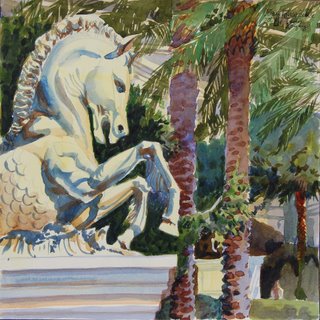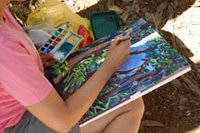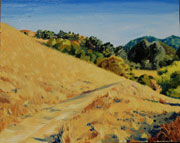Just finished cataloguing all of my artwork. My dad has been helping, sending in work I did when I attended the Art Student's League of San Juan, Puerto Rico back in the late seventies. I've also had to sit down and think of all of the people who've either bought or received art from me in the past 25 years. To answer your question, I didn't do this before because art wasn't a career back then, it was a pastime in which I indulged whenever I had some time off.
I swore off art as a career the day I visited the San Francisco Art Institute to clear up a misunderstanding with their financial aid department. I had been admitted, but also been told the SFAI graduate program did not grant financial aid to non-citizens (I still have the letter). So I waited until arrival in San Francisco to clear up the matter. Apparently they had not heard that Puerto Ricans had been made American citizens prior to the Korean War.
But something happened once I got to the SFAI campus. I could not find the financial aid office, so I walked all over, through their exhibits, classrooms, and administrative offices. Tuition was in the vicinity of $15,000 a year in 1985, and I was asking myself the question "Ok, what do I get for $15,000.?" I sat on a bench in one of their open spaces on the second floor. The view was beautiful, and, as I appreciated the surroundings, I decided right there that I didn't want to pay $35,000. to become a conceptual artist. After this bold insight, I got up and was able to locate the elderly officer of their financial aid office. Just as I thought, she assumed I had applied from Costa Rica. In my awkward English, I told her not to bother.
Was that a good decision? What it terrible to reject the credibility that comes with a SF Art Institute degree? I have often asked myself the same question over the years. Let me know what you think.
Monday, November 27, 2006
Saturday, November 25, 2006
Paris, Las Vegas
 Since I haven't yet gone to the real Paris, I reasoned, Paris Las Vegas, the hotel, will do. I stationed myself at a corner wedged between the hotel wall and the fountain. The fountain was inspired on the one at the Place de la Concorde, which in turn was inspired on the ones at Saint Peter's Square in the Vatican. Nothing is new.
Since I haven't yet gone to the real Paris, I reasoned, Paris Las Vegas, the hotel, will do. I stationed myself at a corner wedged between the hotel wall and the fountain. The fountain was inspired on the one at the Place de la Concorde, which in turn was inspired on the ones at Saint Peter's Square in the Vatican. Nothing is new.The falling water's roar was almost unbearable, and the mist made everything colder. In short, I was in my element, so I started painting, happy to be away from cigarette smoke and protected from the maddening crowds. Andrea Bocelli's voice reached me from across the street and thick traffic, and suddenly, the heads of every passer-by turned to face its origin. The huge fountain at the Bellagio had been activated.
I could now focus on the problem at hand. After the pencil drawing I could see the statues would steal the show, but I wanted to fight against my tendency to include too much background detail. Even though they occupied most of the space in the 12 x 12" Aquarello (Cartiera Magnani) sheet, I knew that the manner in which I treated the background would "make or break" this picture. So I asked myself: What do I simplify, and how do I do it?
I omitted most of the people walking within my line of view. I could not rely on spectators staying there long enough for me to paint them. I also used a purple wash over all of the background, except for the sky. Speaking of the sky, I left out the majority of the clouds, too wispy and white to make it in this "battle of the values." Finally, I left out some signs on the street which I thought would be distracting.
My approach varies. Sometimes I do the background first, sometimes the foreground. Sometimes I work on both simultaneously, especially if I am not yet sure of whether there will be enough contrast. In this picture, I did exactly that. It was a cold palette, reflective of the cold day it was.
Yes, But

I don't smoke, don't gamble, hate to lose money and can hardly tolerate hotel food, so what was I doing in Las Vegas? Painting was an excuse to escape our very wet Winter and Spring, so there I was, outdoors, at a time when even outdoor pools are closed in Sin City, with my 10 x 14" Lanaquarelle block and my tiny color box. I walked quite a bit during that sunny morning looking for a spot that would not be too exposed to the cold wind, and that could afford me an interesting view, and I found... the poolside at Caesar's Palace. No one was out there that early, they were inside, eating breakfast at the buffet restaurant. I could see them, but they could not see me. Security checked me out. I saw a couple of managers discreetly take a peek at what I was doing, but I guess I must have passed, because no one spoke to me until I was almost done.
A middle-aged woman approached slowly. "A painter," I thought quickly, as they are the only creatures daring enough to disturb The Artist At Work. I had noticed her husband warning her it wasn't a good idea, then remaining at a prudent distance, least The Artist be in a bad mood that morning. "Watercolor," she diagnosed, and paused for a moment. "Do you paint?" I replied simply. "Yes, but." I stole a quick glance at her hesitation. She had arrived at that critical moment when you are placing the darkest values in deserving spots, and I could not afford to study her expression. "But what?" I shot back, not looking at her this time.
"I'm afraid to paint outside." She looked at her husband for a second, who was gesturing for her to leave me alone. "I am very shy or very lazy, one of those two. I would love to do landscapes, or the streets in my town, but I can't handle strangers judging me." "But you are not judging me right now, are you?" "No, but that's because I know what it must feel like being out here." She turned her head to the statue I was painting.
I asked her how long had she been painting watercolors, and learned she had been doing it for years. She had even gone to art school. Suddenly it hit me. I had been too distracted by the painting. "Did they do critiques in art school? Were you terrified of those?" "Oh I hated them, but I was too young to rebel." She waved for her husband to go inside the hotel without her. "Well, don't you think this is the reason you feel uncomfortable painting in public places?" Long pause, then "Must be, but now it's too late." Why is it that some people believe their life is over as soon as they hit forty? "It's never too late. You need to get out there, but slowly, with much encouragement, and stop being your own worst judge. Some of my paintings are good, some are bad and some are neither. I have had to force myself to stop judging my work, and stop being afraid of what others might say."
We went on to talk about materials, technique, and finally, selling. By then other hotel guests had started to come out to see if the pools were indeed closed, and the loudspeakers had begun blaring a multi-generational mix of hotel fare. My watercolor was finished and my butt hurt from sitting on a rough granite slab for 90 minutes, so we shook hands and she went in to look for her husband.
Saturday, November 11, 2006
More Maui


These are two others I did close to the beach, one of them inside the car for lack of a proper place to sit. Neither of these views had a dramatic element, so I settled on the mountains as the focal point for both. The beach was wonderful that afternoon, meaning there was very little wind and very few people. Crabs crawled out of their burrows, looking for food close to my bare feet. Behind me was the road and our parked rental car.
Painting inside a car is the pits, unless it's freezing. There's no place to set your water container, and the dashboard will block the lower part of your picture. I balanced the watercolor paper block on my knees to give myself some distance, and worked as quickly as possible. Even with the doors open, it gets hot and the vinyl sticks to your body. Ugh.
Painting in Maui


Sorry about the previous rant. I just had to get it off my chest so I could talk about the more pleasant aspects of painting while vacationing. For this five day trip I took:
- a pocket box (I fill it with my own colors)
- plastic mixing pan about 7" x 10"
- foldable water "bucket"
- three brushes in their own case
- 12" x 16" block of paper
- mechanical pencil (never needs sharpening)
- plastic container with my paint tubes
- small natural sponge
- one bottle of water for each painting
- kneadable eraser
- paper towels
- hat, shades, sunscreen
My partner Sarah, is very supportive. She usually takes a novel and reads while I work. Sometimes she also keeps tourists or gawkers at a reasonable distance. All are very polite, but they are all so curious they will start conversations if given a chance. I also try not to work alone in remote places for safety reasons. When I am working, I am so focused I cannot pay attention to my surroundings.
I did six paintings. The Haleakala crater was the most demanding. Temperature up there at 10,000 feet drops 30 degrees and my hands froze despite the anorak I was wearing. There were tourists all around, trying to get the best picture. A woman sat next to me and proceeded to interrogate me about the origins of my accent. And the Arches paper was getting on my nerves.
The beach, by contrast, was easy. I was sitting in the shade, on a mat, and there were very few people around. The light changed fast, but I've gotten used to this. The water was an incredible turquoise blue, and the vocanic rock was so black I used Payne's Gray as the first layer. By then I had been in Maui for almost 48 hours and felt ready to tackle the colors.
Good Quality

The first rule: Don't try out anything new on a combination painting/traveling trip. Let me now tell you how I broke this most cardinal of principles. A day before our five day trip, I went to the art store and bought two very important items, a round brush and a block of watercolor paper. I figured I'd be safe with Arches, but with the brush I took a risk.
The salesperson at Flax had been at that department for what seemed like the last two decades, so when he said, "that's a good brush," I listened. I shouldn't have, but I bought the brush anyway based on a simple trial with a bit of water they keep for that purpose. This Princeton brush had a big belly, a short point, and an absurdly big ferrule for its size. I also didn't like the length of its handle. But I bought it anyway, because I was going on a trip and wanted the thrill of something new.
As it turns out, both the brush and the paper failed miserably. The heavy sizing in this smooth-surfaced paper caused washes to look uneven no matter what I did, and a second layer of color lifted whatever I had laid first. Dark colors did not look dark enough, and very quickly I saw the 140 lb. Arches block would not take much manipulation either: I refrained from erasing my very light pencil marks.
The brush was another story. It didn't keep a stiff point. Even after shaking excess water off, I had the distinct feeling I was working with squirrel hair (even though it was supposed to be Kolinsky). I ended up using a smaller Windsor and Newton brush for details and leaving the Princeton for washes and scumbling. Worst of all, have you ever painted while swearing?
The lesson: Keep the tried and true, specially if you anticipate exciting views or dramatic subjects on your trip. Beginners, there is nothing worse than working with watercolor paper that betrays you. In the end, you can overcome a bad brush but not bad paper. At an art store in Berkeley the other day, the manager asked me if I knew "what the best watercolor paint" was. "I just want to get whatever the best is." "You can start with a good paper," I said. She asked me why. After all, she explained, she was a beginner. Bad papers, I replied, "can sabotage your best efforts. You'll never know what you're capable of if you keep using bad paper. Buy the best you can afford, then forget it's so expensive." We both laughed at the absurdity of this advice.
Friday, November 10, 2006
Plein Air

 I took advantage of the mild October weather (read: not rainy) to do a couple of quick oils in the park behind our house. Finding a cow-free spot requires a mile-long trek uphill through hot dusty fireroads. I normally take a $30. aluminum portable easel, a hat, a snack, a bottle of water, my sunglasses, a long sleeved shirt, and a foldable chair that doubles as backpack. Inside are no more than six tubes of basic colors, a pad of disposable palette paper, some turpentine, a set of about 20 hog brushes, a bit of stand oil, and some rags. Sometimes I bring a pencil, but most of the time I forget.
I took advantage of the mild October weather (read: not rainy) to do a couple of quick oils in the park behind our house. Finding a cow-free spot requires a mile-long trek uphill through hot dusty fireroads. I normally take a $30. aluminum portable easel, a hat, a snack, a bottle of water, my sunglasses, a long sleeved shirt, and a foldable chair that doubles as backpack. Inside are no more than six tubes of basic colors, a pad of disposable palette paper, some turpentine, a set of about 20 hog brushes, a bit of stand oil, and some rags. Sometimes I bring a pencil, but most of the time I forget.
It takes me anywhere from one to two hours to complete a 16" by 20" canvas, if it's not too windy. I try to find a shady spot, but if I do, I end up wearing a jacket. All that sitting makes you lose your body heat eventually. As with watercolors, size makes a big difference in your execution. A smaller canvas means you can spend more time on details you'd have to ignore otherwise. The smaller your painting surface, the more thought you can give to what you're painting.
What do I think about? I periodically survey the whole picture from a distance. If I cannot get up to look at it from four to five feet, I half-close my eyes to obliterate seductive but ultimately periferal details. I also keep a running list of what I need to correct. Some corrections I leave for home, and some need to be immediate. At times I stop and just look very carefully. Later, I might use that memory to modify an element in the picture. In short, plein air painting is about constant revision, or revision-on-the-go.
Subscribe to:
Comments (Atom)